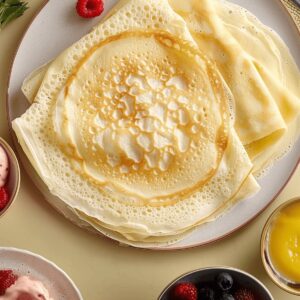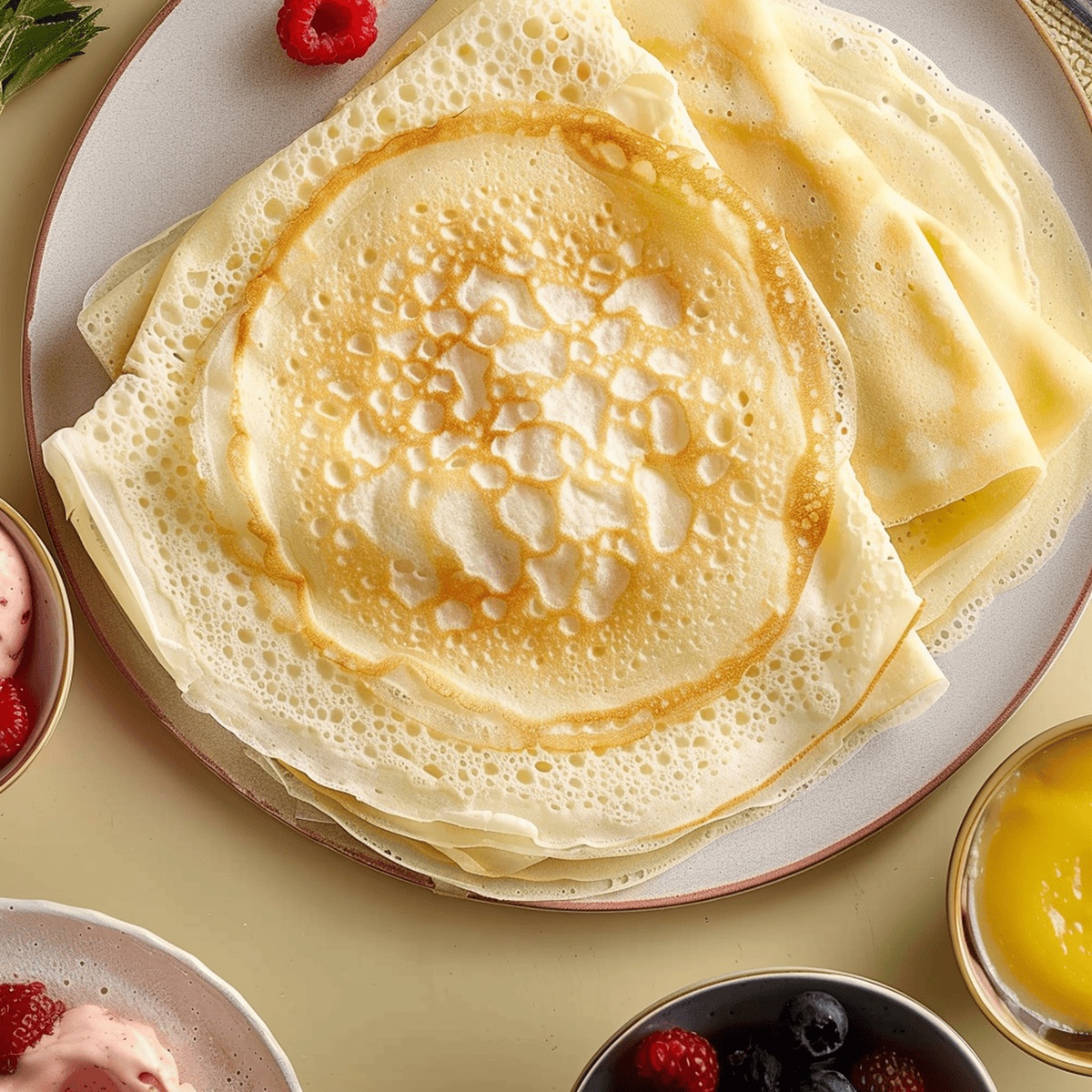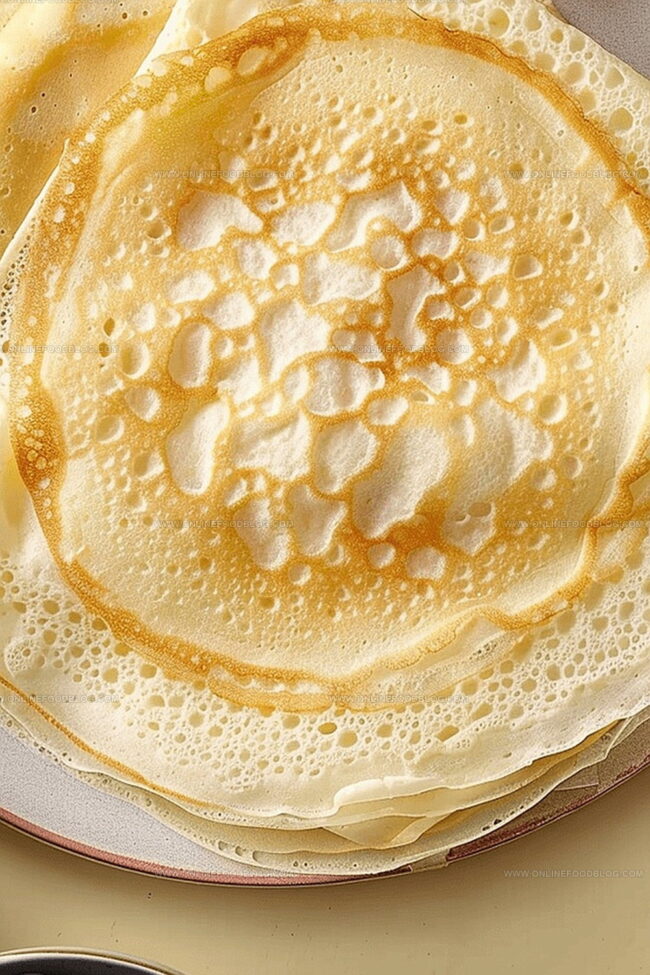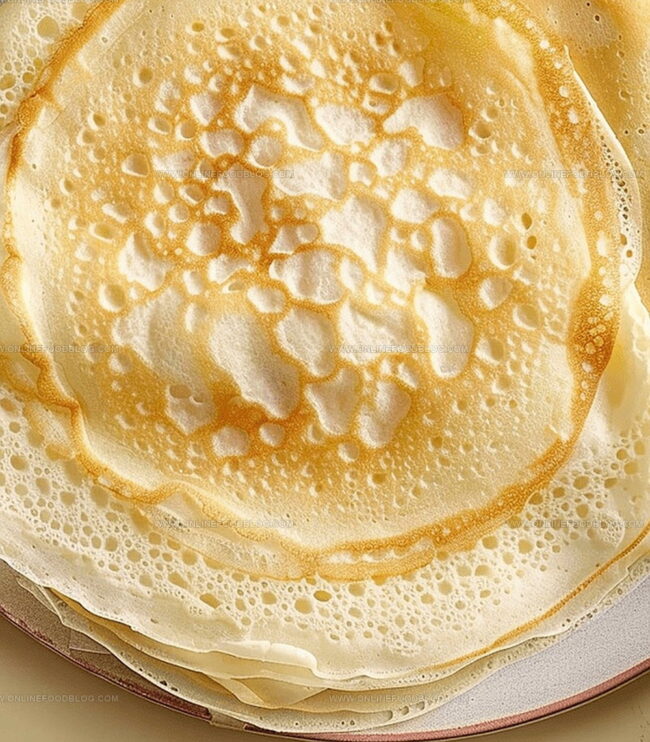Heavenly Classic French Crepes Recipe: Buttery Thin Delights
Light and delicate crepes stand as a culinary art form that refines simple ingredients into an elegant dining experience.
Whisper-thin layers of batter create a canvas for countless sweet and savory possibilities.
French kitchens have perfected this versatile dish through generations of careful technique and passionate cooking.
Silky smooth textures emerge from a precise balance of flour, eggs, and liquid that dance together effortlessly.
Crisp edges and tender centers make these delicate pancakes a delightful treat for breakfast, dessert, or a satisfying snack.
Mastering the gentle swirl and perfect temperature requires practice but promises delicious rewards for curious cooks.
You’ll find joy in creating these paper-thin delights that celebrate simplicity and sophistication.
Why These Crepes Are a French Classic
What You Need for Parisian Perfection
Dry Ingredients:Wet Ingredients:Cooking Essentials:Flip, Fold, and Fill with Flair
Step 1: Blend Crepe Batter
Gather your ingredients:Toss all ingredients into a blender and whirl until silky smooth for about 30 seconds. Pop the mixture into the refrigerator for 30 minutes or up to 1 day. Before cooking, give the batter a quick stir.
Step 2: Prepare Skillet
Heat an 8-inch nonstick skillet over medium heat. Gently brush the pan with a light layer of butter to prevent sticking. This creates a perfect golden surface for your crepes.
Step 3: Pour and Swirl Batter
Pour of batter into the center of the skillet. Quickly tilt and swirl the pan in a circular motion to spread the batter evenly across the bottom. Aim for a thin, uniform layer that covers the entire surface.
Step 4: First Side Cooking
Let the crepe cook until golden spots appear on the bottom and the edges start to lift slightly from the pan. This typically takes 1 to 1 1/2 minutes. Watch for those delicate color changes that signal perfect cooking.
Step 5: Flip with Finesse
Use an offset spatula to gently lift one edge of the crepe. Carefully flip the crepe using your fingers or the spatula, ensuring a smooth transition.
Step 6: Finish Second Side
Cook the flipped side until it’s just set and develops golden spots, which takes about 45 seconds. Slide the finished crepe onto a paper towel-lined plate.
Step 7: Continue Cooking
Repeat the process with remaining batter, adding butter to the pan as needed. Stack the crepes directly on top of each other and let them cool to room temperature before serving.
Pro Tip: Practice makes perfect! Your first few crepes might not look ideal, but you’ll quickly develop the technique for creating restaurant-worthy French crepes.
Tips for Soft, Foldable Crepes Every Time
How to Store Crepes So They Stay Silky
Great Fillings and Pairings to Try
Crepe Styles to Switch Things Up
Print
Classic French Crepes Recipe
- Total Time: 30 minutes
- Yield: 8 1x
Description
Delicate French crepes whisper elegance from Paris kitchens, bringing silky simplicity to breakfast or dessert. Thin, light wheat pancakes roll around sweet or savory fillings, inviting you to savor each delectable bite of culinary tradition.
Ingredients
Dairy and Eggs:
- 1 ½ cups whole milk, room temperature
- 4 large eggs, room temperature
- 3 tablespoons (45 milliliters) unsalted butter, melted, plus more for brushing
Dry Ingredients:
- 1 cup (120 grams) unbleached all-purpose flour
- 1 tablespoon (12 grams) granulated sugar
- ¼ teaspoon kosher salt
Additional Ingredients:
- Additional unsalted butter for brushing
Instructions
- Craft a silky-smooth crepe batter by combining flour, sugar, salt, milk, eggs, and butter in a blender. Pulse for approximately 30 seconds until the mixture achieves a uniform, velvety consistency.
- Chill the prepared batter in the refrigerator for 30 minutes, allowing the ingredients to meld together. The batter can be stored for up to 24 hours; give it a quick stir before use.
- Position an 8-inch (20 centimeters) nonstick skillet over medium heat. Delicately brush the surface with a thin layer of butter to prevent sticking.
- Pour precisely of batter into the center of the skillet. Immediately tilt and swirl the pan to distribute the batter evenly, creating a thin, uniform layer that covers the entire bottom.
- Allow the crepe to cook until the bottom develops golden patches and the edges begin to slightly lift from the pan, approximately 1 to 1.5 minutes.
- Gently slide an offset spatula under one edge of the crepe, then use your fingertips to carefully flip it over, revealing the golden-brown side.
- Cook the second side for about 45 seconds, or until it becomes lightly set with golden speckles.
- Transfer the finished crepe to a paper towel-lined plate, allowing excess moisture to be absorbed.
- Repeat the cooking process with the remaining batter, reapplying butter to the skillet as needed. Stack the crepes directly on top of each other, allowing them to cool to room temperature before serving.
Notes
- Resting the batter is crucial for developing smooth, tender crepes by allowing flour to absorb liquid and gluten to relax.
- Use a nonstick skillet and minimal butter to ensure easy flipping and prevent sticking without greasy residue.
- Swirl batter quickly and evenly to create thin, delicate crepes with consistent thickness across the pan.
- Keep heat at medium to achieve golden-brown edges without burning, which helps develop rich flavor and perfect texture.
- Stack warm crepes immediately to keep them soft and prevent drying out during cooking process.
- Experiment with sweet or savory fillings like Nutella, fresh fruits, ham, or cheese to transform this versatile French classic.
- Prep Time: 10 minutes
- Cook Time: 20 minutes
- Category: Breakfast, Snacks, Desserts
- Method: Blending
- Cuisine: French
Nutrition
- Serving Size: 8
- Calories: 182 kcal
- Sugar: 2.5 g
- Sodium: 90 mg
- Fat: 10.5 g
- Saturated Fat: 6 g
- Unsaturated Fat: 3.5 g
- Trans Fat: 0.3 g
- Carbohydrates: 16 g
- Fiber: 0.5 g
- Protein: 6.5 g
- Cholesterol: 110 mg




Lucas Bennett
Founder & Recipe Creator
Expertise
Simple Everyday Recipes, Sustainable Cooking Practices, Creative Meal Planning, Recipe Testing and Improvement
Education
Fox Valley Technical College, Appleton, Wisconsin
Lake Superior College, Duluth, Minnesota
Lucas Bennett’s cooking journey started in his parents’ kitchen, where he learned to prepare tasty, no-fuss meals from scratch. His culinary passion led him to Fox Valley Technical College, where he gained practical cooking skills.
He then expanded his focus on sustainability at Lake Superior College. Today, Lucas shares easy, approachable recipes designed to make cooking enjoyable and stress-free for everyone.